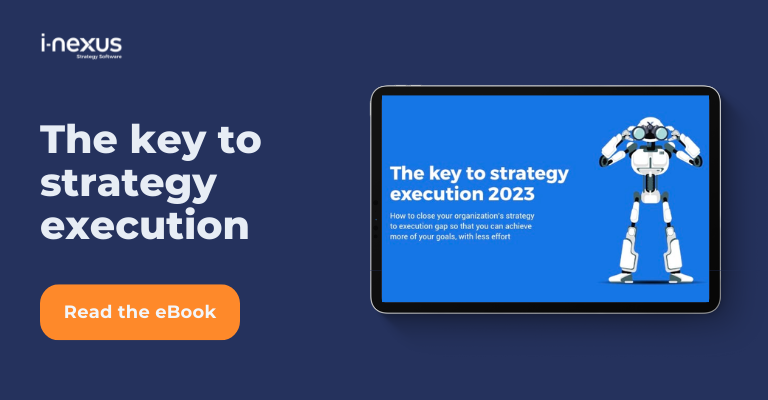How do you raise the bar on daily performance, and what are your strengths and weaknesses for delivering goals? These are the questions you need to ask about your organization's abilities.
Written by: Nigel Richardson, Head of Pre-Sales
Executing strategic, operational and transformational programs require the right people, process and technologies.
With competing initiatives, resource and often an unmitigated flow of information, raising the bar on the three core forms of organizational focuses – strategy deployment, continuous improvement and transformation – is undeniably challenging.
Driving change and achieving your goals must begin with a capabilities profile.
What is a capabilities profile?
Gauging the existing performance levels of the different aspects of your organization, or for any endeavor in life for that matter, is key to improvement. When focusing on your strategic abilities, we recommend considering these core areas:
- People
- Processes
- Technology
- Measures
- Data
Today I want to cover some of the simple to ask, but difficult to answer questions that give you a starting point to profile and understand the engine you have in place to deliver your organization’s goals.
What themes run through an organizational capabilities profile?
The fundamental principles explored are:
1) In today’s world, uncertainty is the only certainty. Planning must change from a static output to one where we are capable of course correcting a plan where needed.
2) The difference between the communication of goals and cascading accountability.
3) Joining up the three core strategic organization focuses - long-term strategy deployment, continuous improvement and transformation.
The 8 questions you should ask about your organization's capabilities
1. How do you prioritize your goals and execution projects?
This is the first question for two simple reasons and sets the tone for gauging your capabilities:
- It tests what is important and the criteria which determines the initiatives you focus on, and
- It indicates your understanding of the reasons to stop activity and initiatives that conflict with or misalign to your priorities
When the why is understood, prioritizing goals becomes a simpler conversation.
2. How many top-level strategic goals require a significant transformation of, or in, your business?
New Year’s resolutions are predicated by “stop” or “start”. Seldom “continue”, so change is in their nature.
We all know from personal experience one resolution, turned into the plethora of daily decisions and discipline, is hard enough.
You will hear organizations talk about “breakthrough goals”, “step change”, or “shifts” in performance. These goals cannot be achieved by nudging or incrementally improving the current state operating model (e.g. people, process, technology, products).
These transformational goals can be disruptive in nature and seen to compete with daily tasks. Therefore, successful companies limit their step change goals, focusing on two-three within each yearly execution cycle.
3. How do you manage the portfolio of execution projects?
How do you get a complex, multi-disciplined (often geographically dispersed) set of teams, functions and divisions playing in harmony for your organization?
Imagine an orchestra...is everyone all playing to the same rhythm or in the same key? Is there a single conductor advising which areas need to strengthen their performance, alter pace or volume to align to the greater performance?
4. How well are your strategic goals defined?
Do you communicate or do you cascade?
An organization that communicates its goals well aims to ensure all staff understand the five or six goal statements / themes of corporate focus.
Roadshows, all hands meetings etc. – an assortment of broadcast information is often invested, with the hope that employees use this information to guide decision making and their behavior.
Yet disparate sources of goals, objectives and value statements rarely mutually reinforce difficult project management or improvement opportunities.
For some organizations, employees knowing the business strategy is enough and they will focus their decision making around the strategic goals. But are you confident all leaders and teams will take accountability to bring challenging goals to reality? Or are they likely to play to their own tune?
Cascaded vs. communicated goals
Cascading goals ensure leaders and teams at all levels identify goal statements that align to the top-level organizational goals.
Defining a cascaded goal

A cascaded goal is:
- Personal: Specific to the individual or team
- Connected: The owner can tell the story of how that goal rolls up through their reporting line to ultimately fulfil one or more of the top-level organizational goals
- Negotiated: Goals that involve expected future performance cannot fully be embraced without dialogue on how they will be achieved and the support needed to deliver the future expected performance
Failure to cascade meaningful goals across business units is a significant challenge mentioned by 30% of business leaders.
Harvard Business Review, 2015.
5. How many of your staff are you confident understand the organization's goals and the role they need to play?
Many companies fail in their strategy execution. Are you confident that your employees are aligned to your strategic goals in their day to day operation?
This question relates to the overall depth that those conversations have permeated through the organization about your goals.
If the coach is in contact with the team captain on the nature of the play, how well do the rest of the team members understand that goal and can then play their role effectively?
Communication remains a prevalent challenge for an organization’s ability to deliver its goals. Indeed, it is not easy.
6. Do you have a single engine of strategy execution that you can rely on?
Significant investment is made within your organization in regard to people, process and technology, all in the pursuit of managing performance driven by timely facts.
However, a 2019 survey by New Vantage Partners shows that 62% of organizations see measurable results from incorporating data into their decision making.
Therefore, possessing a single engine where information is entered, tracked, measured, and used to drive the achievement of your goals is logical.
However, investment in this area remains woefully inadequate for many organizations. They continue to use outdated means such as Excel or PowerPoint to track this business critical function. Consider whether your organization has the right solution to underpin your efforts and give you the best chance of success.
7. How secure and reliable is your organization's strategy execution toolset?
Privacy is of paramount importance in modern times, not least because of numerous data breaches that have a crippling impact on an organization’s bottom-line and reputation.
Sharing plans and reports over email is the norm, and whilst segregating access via SharePoint or similar software is one such solution, it is hardly foolproof.
Most of your operational or enabling data (e.g. HR) is hosted in a secure SaaS environment. The logic should equally apply to the plethora of information on goals, projects and KPI target performance that delivers your competitive advantage and is critical to your organization’s success.
8. How effective is your strategy governance in safeguarding the execution?
Back to the orchestra. What is the rhythm that the conductor is managing to?
Performance management of progress and results is only as good as the frequency of the conversations to review them.
As mentioned earlier, uncertainty is the only certainty.
Course correction or being able to support a corrective action culture is necessary to be able to deliver against your strategic, operational and transformational goals.
It’s crucial to be able to change course based on factors around delivery that are in your control, or external shifts in the market, societal views, market entrants etc. which are out of your control.
Governance, in the form of regular entry of information and performance reviews can ensure execution is safeguarded.
So, what now?
If you would like to assess your organization's capability to ensure success in your strategy execution then I’d like to invite you to complete our StratexAssess tool.
For your efforts you will get a tailored report based on 16 measures of strategic capabilities, telling you exactly where your organization stands, and receive a complimentary consultation with guidance on how to improve your performance.
What outcomes should you expect from the StratexAssess report?
The results of the capabilities profile will put your organization into one of three brackets:
- The reality that your capabilities are stifling performance, and investment should be placed in people and process.
- You are trying to achieve the change, but difficulties around process and traditional tools are making this difficult.
- Your capabilities are strong, however you would like to improve the underlying performance by digitalizing your processes.
Want to learn more about the factors impacting your strategy execution?
Click here to visit our strategy execution knowledge hub, filled with content to support you in embracing the 'no normal' of strategy in the 2020s and beyond, or explore these recommendations:
- How to get your strategy to play ball with the catchball process: Great strategy makes use of the catchball process. Here’s what that means and how you can integrate it.
- 5 ways to ensure your strategic objectives don't get lost through the grapevine: Discover 5 ways you can improve the clarity and cascade of your objectives.
- The key to strategy execution: Explore the benefits of excellent strategy execution, the organizations that have succeeded, and how your business can follow suit.
About the author
Nigel Richardson is i-nexus’ Head of Pre-Sales. His background spans 15 years in business transformation and continuous improvement across retail, pharma, aviation and IT supply chain. He is passionate about supporting organizations to achieve their strategic, transformational and improvement goals, and outperform their peers year after year.
If you’d like to talk more about your strategic challenges, reach out to him on nigel.richardson@i-nexus.com or connect with Nigel on LinkedIn for the latest strategy execution insights.




